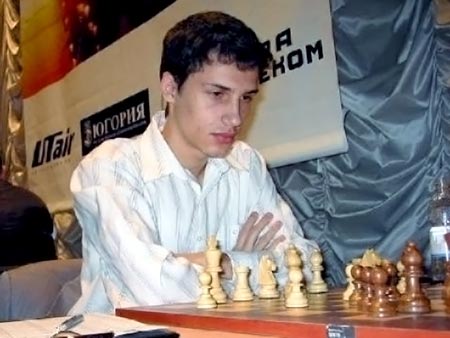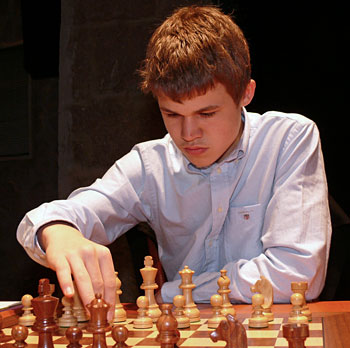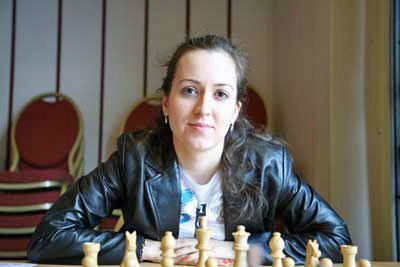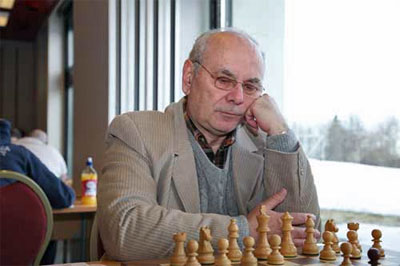| Latest | Greatest | Lobby | Journals | Search | Options | Help | Login |
|
|
|
This topic is archived. |
| Home » Discuss » Topic Forums » Sports |
|
| Jack Rabbit
|
Sun Apr-29-07 02:03 PM Original message |
| The Jack Rabbit Chess Report for April 29 |
|
Edited on Sun Apr-29-07 02:17 PM by Jack Rabbit
The Jack Rabbit Chess Report for the week ending April 29  Contents Post 1: News for the week Post 2: Diagrams and other features Post 3: Games from Current and Recent Events |
| Printer Friendly | Permalink | | Top |
| Jack Rabbit
|
Sun Apr-29-07 02:04 PM Response to Original message |
| 1. News for the week ending April 29 |
|
Cheparinov in runaway win in Malmø
 Bulgarian grandmaster Ivan Cheparinov won the 15th annual Sigeman & Co. chess tournament in Malmø, Skåne (Sweden) by a point and a half over his nearest rivals. Cheparinov socred 7 points (five wins and four draws) out of nine games. Swedes Emanuel Berg and Tiger Hillarp-Persson and Dutch grandmaster Jan Timman, the defending tournament champion, finished tied for second with 5½ points each. Unofficial Cross Table Sigeman & Co. Tournament Malmø, Skåne (Sweden) -------------------------- 1 2 3 4 5 6 7 8 9 0 T- (W) .1 Ivan Cheparinov. . . . .- ½ 1 ½ ½ 1 1 ½ 1 1 7. (5) .2 Jan Timman . . . . . . .½ - 1 1 1 ½ 0 ½ 0 1 5½ (4) .3 Emanuel Berg . . . . . .0 0 - ½ ½ 1 1 ½ 1 1 5½ (4) .4 Tiger Hillarp-Persson. .½ 0 ½ - 1 ½ ½ 1 1 ½ 5½ (3) .5 Pontus Carlsson. . . . .½ 0 ½ 0 - 1 1 ½ 1 ½ 5. (2) .6 Vasilios Kotronias . . .0 ½ 0 ½ 0 - ½ 1 1 1 4½ (3) .7 Parimarjan Negi. . . . .0 1 0 ½ 0 ½ - 0 1 1 4. (3) .8 Erwin L'Ami. . . . . . .½ ½ ½ 0 ½ 0 1 - 1 0 3. (2) .9 Jonny Hector . . . . . .0 1 0 0 0 0 0 0 - 1 2. (2) 10 Emil Hermansson. . . . .0 0 0 ½ ½ 0 0 1 0 - 2. (1) The Jack Rabbit Unofficial Cross Table uses games won as first tie break Cheparinov was assured of a clear first place finish going into the last round Thursday. Cheparinov often serves as the second to his fellow Bulgarian grandmaster, former FIDE world champion Veselin Topalov. Many observers believe Cheparinov has the potential to rank among the world's elite grandmasters in his own right. Magnus wins Gausdal Tournament  Sixteen-year-old grandmaster Magnus Carlsen of Norway won the Chess Classic in the mountain resort of Gausdal, Oppland (Norway) by defeating his nearest rival, Polish grandmaster Michal Krasenkow, in the final round Thursday. Magnus scored 7 points (5 wins and four draws) in nine games. Krasenkow was the only player with a chance to catch or surpass Magnus, who needed only to avoid loss in order to take a clear first prize. A victory by Krasenkow would have given him a clear first instead. The loss dropped Krasenkow into a three-way for second with Lithuanian GM Eduardas Rozenthalis and Hungarian chess legend Lajos Portisch with 5½ points each. Unofficial Cross Table Chess Classic Gausdal, Oppland (Norway) -------------------------- 1 2 3 4 5 6 7 8 9 0 T- (W) .1 Magnus Carlsen . . . . .- 1 1 ½ ½ ½ ½ 1 1 1 7. (5) .2 Michal Krasenkow . . . .0 - 0 ½ ½ 1 ½ 1 1 1 5½ (4) .3 Lajos Portisch . . . . .0 1 - ½ ½ ½ ½ 1 ½ 1 5½ (3) .4 Eduardas Rozentalis. . .½ ½ ½ - ½ ½ ½ 1 1 ½ 5½ (2) .5 Kaido Kulaots. . . . . .½ ½ ½ ½ - 1 0 ½ ½ 1 5. (2) .6 Irina Krush. . . . . . .½ 0 ½ ½ 0 - 1 0 1 1 4½ (3) .7 Alexey Dreev . . . . . .½ ½ ½ ½ 1 0 - 0 ½ 1 4½ (2) .8 Kjetil Lie . . . . . . .0 0 0 0 ½ 1 1 - ½ 1 4. (3) .9 Gawain Jones . . . . . .0 0 ½ 0 ½ 0 ½ ½ - ½ 2½ (0) 10 Eric Moskow. . . . . . .0 0 0 ½ 0 0 0 0 ½ - 1. (0) The Jack Rabbit Unofficial Cross Table uses games won as first tie break For Carlsen, soon to join the ranks of the world's elite grandmasters, it's the first first prize of the year. He finished tied for second behind Vishy Anand in the Morelia-Linares tournament in March. One of the interesting stories in Gausdal was the success of the 70-year-old Portisch, who played in the candidates' matches of the world championship cycle six times between 1965 and 1983. Kramnik defeats Leko in Rapid Match  World champion Vladimir Kramnik won an eight-game match of rapid chess over Hungarian grandmaster Peter Leko by a score of 4½-3½ in Miskolc, Hungary. The final two games were played earlier today and both ended in draws. Kramnik won games 3 and 5, while Leko scored a full point in game 6. The city of Miskolc hosts an annual rapid match between Leko and another opponent. In 2005, Leko and British grandmaster Mickey Adams fought to a 4-4 drawn match. Last year, Leko defeated former world champion Anatoly Karpov 4½-3½ by winning the only decisive game. Kramnik and Leko met in a 14-game classical match for the world title in Brissago, Ticino Canton (Switzerland) in 2004. That match ended in a 7-7 deadlock and the title reverted to Kramnik. |
| Printer Friendly | Permalink | | Top |
| Jack Rabbit
|
Sun Apr-29-07 02:05 PM Response to Original message |
| 2. Diagrams and other features of the JR Chess Report |
|
!""""""""# $tMvWlVmT% $OoOoOoOo% $ + + + +% $+ + + + % $ + + + +% $+ + + + % $pPpPpPpP% $RnBqKbNr% /(((((((() White to move This position is a theoretical draw Does this picture make sense to you? If not, or if it looks like a bunch of Wingdings, please click here. Diagrams used in the Jack Rabbit Chess Report are made with Chess Merida, a true type font that is available as freeware at the above link. |
| Printer Friendly | Permalink | | Top |
| Jack Rabbit
|
Sun Apr-29-07 02:07 PM Response to Original message |
| 3. Games from current and recent events |
|
Edited on Sun Apr-29-07 02:21 PM by Jack Rabbit
Chess Games Analysis by JR and Fritz Jonny Hector - Ivan Cheparinov, Sigeman & Co Tournament, Round 3, Malmø Magnus Carlsen - Lajos Portisch, Chess Classic, Round 7, Gaudsal Lajos Portisch - Michal Krasenkow, Chess Classic, Round 5, Gaudsal Alexey Dreev - Irina Krush, Chess Classic, Round 3, Gaudsal Award-Winning Games from Dresden, Part 1 of 2 Jessica Nill - Maia Lomineishvili, European Individual Championships, Round 6, Dresden Sang Cao - Viorel Bologan, European Individual Championships, Round 9, Dresden |
| Printer Friendly | Permalink | | Top |
| Jack Rabbit
|
Sun Apr-29-07 02:08 PM Response to Reply #3 |
| 4. Hector - Cheparinov, Round 5, Malmø |
 Ivan Cheparinov Jonny Hector vs. Ivan Cheparinov Sigeman & Co Tournament, Round 5 Malmø, Skåne (Sweden), April 2007 Open Sicilian Game: Najdorf-Dragon Defense 1. e4 c5 2. Nf3 d6 3. d4 cxd4 4. Nxd4 Nf6 5. Nc3 a6 6. Qe2 g6!?
Black: Ivan Cheparinov !""""""""# $tMvW Tl+% $+o+ OoVo% $o+ O Mo+% $+ + + B % $ + NpP +% $+ N + + % $pPp+q+pP% $+ Kr+b+r% /(((((((() White: Jonny Hector Position after 9. f2f4 9. -- Bg4
Black: Ivan Cheparinov !""""""""# $ +t+ +l+% $+o+m+o+o% $o+tO Oo+% $+ + + + % $ + RpP +% $Pb+ + +p% $ +p+ +p+% $+ K + +r% /(((((((() White: Jonny Hector Position after 20. Bc4b3 20. -- Kf8!
Black: Ivan Cheparinov !""""""""# $ +t+ K +% $+ + +o+o% $ + O +o+% $+oTb+o+ % $o+ +pP +% $P Mr+ +p% $ +p+ +p+% $+ + +k+ % /(((((((() White: Jonny Hector Position after 32. Re3d3 32. -- Re8!
|
| Printer Friendly | Permalink | | Top |
| Jack Rabbit
|
Sun Apr-29-07 02:10 PM Response to Reply #3 |
| 5. Carlsen - Portisch, Round 7, Gausdal |
 Magnus Carlsen Magnus Carlsen vs.Lajos Portisch Chess Classic, Round 7 Gausdal, Oppland (Norway), April 2007 Open Queen's Gambit: Catalan Opening 1. d4 d5 2. c4 e6 3. Nf3 Nf6 4. g3 dxc4 5. Bg2 Nbd7
Black: Lajos Portisch !""""""""# $ +t+ +lT% $+ N +oOo% $o+ Qv+ +% $+o+ + + % $ + + + +% $+w+ + P % $ + +pPbP% $+ R + K % /(((((((() White: Magnus Carlsen Position after 22. -- Rb8c8 23. Bb7!
|
| Printer Friendly | Permalink | | Top |
| Jack Rabbit
|
Sun Apr-29-07 02:13 PM Response to Reply #3 |
| 7. Krush-Dreev, Round 3, Gausdal |
 Irina Krush Alexey Dreev vs. Irina Krush Chess Classic, Round 2 Gausdal, Oppland (Norway), April 2007 Open Queen's Gambit: Mannheim Opening 1. d4 d5 2. Nf3 Nf6 3. c4 dxc4 4. Qa4+ Nc6
Black: Irina Krush !""""""""# $t+ WlV T% $OoO +oOo% $ M +p+m+% $+ + + + % $ +o+p+v+% $+ N +nB % $pP + + +% $R +qKb+r% /(((((((() White: Alexey Dreev Position after 11. de6:p (ep) 11. -- Qxd1+!?
Black: Irina Krush !""""""""# $ + + + T% $Oo+ L Oo% $ M +o+ +% $+nT + +r% $ +o+pP +% $+ +m+ P % $pP KbP +% $+ +r+ + % /(((((((() White: Alexey Dreev Position after 21. Ke1d2 21. -- Nxf2!!
|
| Printer Friendly | Permalink | | Top |
| Jack Rabbit
|
Sun Apr-29-07 02:14 PM Response to Reply #3 |
| 8. Nill - Lomineishvili, Round 6, Dresden |
|
Georgian master Maia Lomineishvili is one of many fine women players from the Caucasus mountain republics with an aggressive temperment.
 Maia Lomineishvili Jessica Nill vs. Maia Lomineishvili European Individual Championships, Round 6 Dresden, April 2007 Best Game of Round 6, Ladies' Competition West India Game: King's Indian Defense (Aronin Opening) 1. d4 Nf6 2. c4 g6 3. Nc3 Bg7 4. e4 d6 5. Nf3 0-0 6. Be2 e5 7. 0-0 Nc6 8. d5 Ne7 9. Ne1 Nd7 10. Nd3
Black: Maia Lomineishvili !""""""""# $t+vW Tl+% $OoOm+ Vo% $ + O +m+% $+ +pO O % $ +p+pO +% $+ N +p+ % $pP BbNpP% $+ Rq+rK % /(((((((() White: Jessica Nill Position after 14. Nd3f2 14. -- h5
Black: Maia Lomineishvili !""""""""# $t+vW Vl+% $+oOm+ T % $o+ O +m+% $+ +pO Oo% $ Pp+pOp+% $+ N +p+ % $p+ BbN P% $+ Rq+rK % /(((((((() White: Jessica Nill Position after 19. g3g4 19. -- Rh7!
Black: Maia Lomineishvili !""""""""# $t+v+ +lW% $+oO V + % $o+ O +m+% $P PpO + % $nP +pOo+% $+ + +p+t% $ + BbR P% $+ Rq+ K % /(((((((() White: Jessica Nill Position after 27. c4c5 27. -- g4!
|
| Printer Friendly | Permalink | | Top |
| Jack Rabbit
|
Sun Apr-29-07 02:16 PM Response to Reply #3 |
| 9. Sang Cao - Bologan, Round 9, Dresden |
 Viorel Bologan Sang Cao vs. Viorel Bologan European Individual Championships, Round 9 Dresden, April 2007 Best Game of Round 9, Open Competition Open German Game: Seirawan Opening (Caro-Kann Defense) 1. e4 c6 2. d4 d5 3. Nc3 dxe4 4. Nxe4 Bf5 5. Ng3 Bg6 6. Nf3 Nd7 7. h4 h6 8. h5 Bh7 9. Bd3 Bxd3 10. Qxd3 e6 11. Bf4 Qa5+
Black: Viorel Bologan !""""""""# $ +l+ +t+% $+oWt+oO % $O+ VoM O% $+ + + +p% $ +p+ + +% $+ B + P % $pPn+qP +% $+k+r+ +r% /(((((((() White: Sang Cao Position after 24. Nd4c2 24. -- Rgd8!
Black: Viorel Bologan !""""""""# $ +lT + +% $+o+ +o+ % $o+w+o+ O% $+ +n+ +p% $ +p+ +q+% $+ V + P % $pP T P +% $+k+r+ +r% /(((((((() White: Sang Cao Position after 30. Nf5d5 30. -- R8xd5!!
|
| Printer Friendly | Permalink | | Top |
| Jack Rabbit
|
Sun Apr-29-07 02:11 PM Response to Original message |
| 6. Portisch - Krasenkow, Round 5, Gausdal |
|
Seventy-year-old chess legend Lajos Portisch of Hungary finished tied for second at Gausdal with 5½ points out of nine.
In the sixties, seventies and early eighties, Portisch was among the world's elite grandmasters. He qualified for the world championship candidates' matches in 1965, 1968, 1974, 1977, 1980 and 1983. In his palmy days, Portisch was known as one with a prophylactic positional style similar to former world champion Tigran Petrosian. That style is on display in the following game, where Portisch takes advantage of an early mistake and makes his opponent strangle on it.  Lajos Portisch Michal Krasenkow vs. Lajos Portisch Chess Classic, Round 5 Gausdal, Oppland (Norway), April 2007 Open Queen's Gambit: Mannheim Opening 1. Nf3 d5 2. d4 e6 3. c4 dxc4 4. Qa4+ Nd7 5. e4
Black: Lajos Portisch !""""""""# $t+v+lV T% $Oo+m+oOo% $ W +o+ +% $+ + + + % $q+bRp+ +% $+ N +n+ % $pP + PpP% $+ + K +r% /(((((((() White: Position after 11. Bf1c4:p 11. -- Qxb2!
Black: Lajos Portisch !""""""""# $t+v+ Tk+% $Oo+ +oOo% $ M +o+ +% $+ + + + % $ V +p+ +% $WbNq+n+ % $p+ R PpP% $+ + +rK % /(((((((() White: Position after 17. Qb5d3 17. -- Qa5!
Black: Lajos Portisch !""""""""# $ + W Tl+% $Oo+ +oO % $ +v+o+ O% $+ + Pm+ % $ +t+n+q+% $+b+ + +p% $p+ + Pp+% $+ + + K % /(((((((() White: Position after 29. Rc5c4 29. -- Qa5!!
|
| Printer Friendly | Permalink | | Top |
| DU
AdBot (1000+ posts) |
Tue Apr 30th 2024, 12:35 PM Response to Original message |
| Advertisements [?] |
| Top |
| Home » Discuss » Topic Forums » Sports |
|
Powered by DCForum+ Version 1.1 Copyright 1997-2002 DCScripts.com
Software has been extensively modified by the DU administrators
Important Notices: By participating on this discussion board, visitors agree to abide by the rules outlined on our Rules page. Messages posted on the Democratic Underground Discussion Forums are the opinions of the individuals who post them, and do not necessarily represent the opinions of Democratic Underground, LLC.
Home | Discussion Forums | Journals | Store | Donate
About DU | Contact Us | Privacy Policy
Got a message for Democratic Underground? Click here to send us a message.
© 2001 - 2011 Democratic Underground, LLC